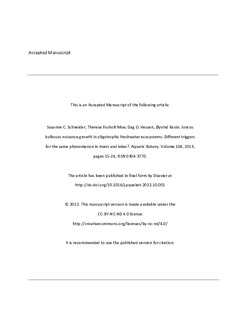| dc.contributor.author | Schneider, Susanne Claudia | |
| dc.contributor.author | Moe, Therese Fosholt | |
| dc.contributor.author | Hessen, Dag Olav | |
| dc.contributor.author | Kaste, Øyvind | |
| dc.date.accessioned | 2018-11-05T13:25:55Z | |
| dc.date.available | 2018-11-05T13:25:55Z | |
| dc.date.created | 2013-02-27T14:17:00Z | |
| dc.date.issued | 2013 | |
| dc.identifier.citation | Aquatic Botany. 2013, 104, 15-24. | nb_NO |
| dc.identifier.issn | 0304-3770 | |
| dc.identifier.uri | http://hdl.handle.net/11250/2571009 | |
| dc.description.abstract | Since the 1980s nuisance growth of the aquatic macrophyte Juncus bulbosus has been observed in an increasing number of rivers and lakes in Europe. Freshwater acidification, lake liming, as well as the impact of hydropower plants and climate-related parameters have previously been assumed to have caused J. bulbosus mass development, but are unlikely to be the sole reason for today's phenomenon. To explore causalities for J. bulbosus mass development and to assess whether or not different patterns emerge in rivers and lakes, we analyzed macrophyte vegetation, periphyton coverage, water and sediment chemistry, catchment characteristics, and J. bulbosus elemental composition in 17 lakes and 28 river sites in southern Norway. We found that J. bulbosus mass development generally is a phenomenon of the most phosphorus- and calcium-poor rivers and lakes. This likely is a result of increased competition from other macrophyte species in all but the very most oligotrophic and acidic ecosystems. Despite a large number of measured parameters, however, we still lack clear correlations to J. bulbosus success. Nevertheless, our results with respect to changes in water CO2 and plant carbon content were consistent with literature suggesting CO2 as the most likely factor causing J. bulbosus mass development in lakes. While J. bulbosus seems to be carbon-limited in lakes with low J. bulbosus abundance, we have no such indications in high-abundance lakes. For rivers, our study indicates that the factor most closely connected to J. bulbosus success is a slightly enhanced NH4+ supply. We suggest that different factors may be responsible for J. bulbosus nuisance growth in rivers and lakes. | nb_NO |
| dc.language.iso | eng | nb_NO |
| dc.publisher | Elsevier | nb_NO |
| dc.rights | Attribution-NonCommercial-NoDerivatives 4.0 Internasjonal | * |
| dc.rights.uri | http://creativecommons.org/licenses/by-nc-nd/4.0/deed.no | * |
| dc.title | Juncus bulbosus nuisance growth in oligotrophic freshwater ecosystems: Different triggers for the same phenomenon in rivers and lakes? | nb_NO |
| dc.title.alternative | Juncus bulbosus nuisance growth in oligotrophic freshwater ecosystems: Different triggers for the same phenomenon in rivers and lakes? | nb_NO |
| dc.type | Journal article | nb_NO |
| dc.type | Peer reviewed | nb_NO |
| dc.description.version | acceptedVersion | nb_NO |
| dc.source.pagenumber | 15-24 | nb_NO |
| dc.source.volume | 104 | nb_NO |
| dc.source.journal | Aquatic Botany | nb_NO |
| dc.identifier.doi | 10.1016/j.aquabot.2012.10.001 | |
| dc.identifier.cristin | 1014968 | |
| dc.relation.project | Norges forskningsråd: 179569 | nb_NO |
| cristin.unitcode | 7464,30,19,0 | |
| cristin.unitcode | 7464,30,23,0 | |
| cristin.unitname | Ferskvannsøkologi | |
| cristin.unitname | Nedbørfeltprosesser | |
| cristin.ispublished | true | |
| cristin.fulltext | postprint | |
| cristin.qualitycode | 1 | |

